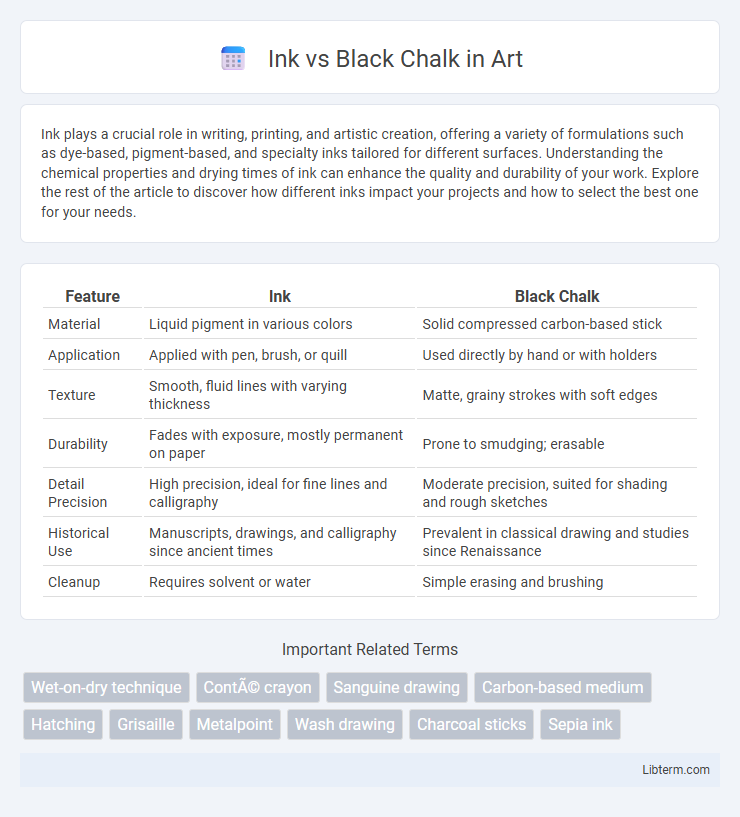Ink plays a crucial role in writing, printing, and artistic creation, offering a variety of formulations such as dye-based, pigment-based, and specialty inks tailored for different surfaces. Understanding the chemical properties and drying times of ink can enhance the quality and durability of your work. Explore the rest of the article to discover how different inks impact your projects and how to select the best one for your needs.
Table of Comparison
| Feature | Ink | Black Chalk |
|---|---|---|
| Material | Liquid pigment in various colors | Solid compressed carbon-based stick |
| Application | Applied with pen, brush, or quill | Used directly by hand or with holders |
| Texture | Smooth, fluid lines with varying thickness | Matte, grainy strokes with soft edges |
| Durability | Fades with exposure, mostly permanent on paper | Prone to smudging; erasable |
| Detail Precision | High precision, ideal for fine lines and calligraphy | Moderate precision, suited for shading and rough sketches |
| Historical Use | Manuscripts, drawings, and calligraphy since ancient times | Prevalent in classical drawing and studies since Renaissance |
| Cleanup | Requires solvent or water | Simple erasing and brushing |
Introduction to Ink and Black Chalk
Ink, a versatile medium composed of pigments or dyes suspended in liquid, has been used for centuries in writing, drawing, and printing due to its rich, permanent qualities. Black chalk, a natural drawing material derived from mineral carbon, offers artists a matte texture ideal for sketching and shading with a soft, smoky effect. Both mediums serve distinct creative purposes, with ink providing precision and permanence while black chalk delivers subtle tonal variation and tactile depth.
Historical Background of Drawing Materials
Ink and black chalk have long served as fundamental drawing materials with distinct historical backgrounds. Ink, dating back to ancient civilizations like Egypt and China, was prized for its permanence and versatility in manuscript illumination and detailed illustrations. Black chalk, widely used during the Renaissance, provided artists with a softer, more nuanced medium ideal for sketching and preparatory studies, deeply influencing classical drawing techniques.
Composition and Characteristics of Ink
Ink is primarily composed of pigments or dyes suspended in a liquid solvent, often water or oil-based, combined with additives like binders and preservatives to enhance flow and durability. Its fluid consistency allows precise application on various surfaces, drying quickly to form permanent, smudge-resistant marks. Ink's versatility and opacity enable vivid color representation and fine detail, making it essential for writing, drawing, and printing.
Composition and Characteristics of Black Chalk
Black chalk is composed primarily of natural carbonaceous materials mixed with clay, providing its rich, deep tone and smooth texture ideal for detailed drawing. Its granular structure allows for precise lines and subtle shading, making it favored by artists for portrait and figure sketches. The pigment's versatility and ability to produce both sharp and soft effects distinguish black chalk from ink, which is typically more fluid and less forgiving in texture and shading.
Techniques of Drawing with Ink
Techniques of drawing with ink include using pens, brushes, and nibs to create precise lines, varied textures, and shading effects. Artists employ hatching, cross-hatching, stippling, and washes to build depth and contrast, utilizing the fluidity and permanence of ink for strong visual impact. Unlike black chalk, ink allows for fine detail and bold expression, making it ideal for calligraphy, illustrations, and graphic art.
Techniques of Drawing with Black Chalk
Techniques of drawing with black chalk emphasize its versatility in creating rich, textured lines and subtle shading through cross-hatching and smudging. Artists exploit the chalk's softness to achieve a range of tones, from light grays to deep blacks, ideal for expressive portraits and detailed studies. Precision and control are maintained by adjusting pressure and using tools like stumps or fingers for blending, distinguishing black chalk drawings from ink's more permanent and linear qualities.
Visual Impact: Ink vs Black Chalk
Ink creates bold, crisp lines that deliver a strong, defined visual impact, making details stand out with high contrast on paper. Black chalk offers a softer, textured appearance, producing subtle gradients and a more organic, tactile feel that emphasizes depth and shading. The choice between ink and black chalk significantly influences the artwork's mood and spatial perception by varying line intensity and surface texture.
Preservation and Longevity
Ink offers superior preservation and longevity compared to black chalk, as it is less prone to fading and smudging over time. Archival-quality inks are often formulated to resist moisture, light, and chemical degradation, ensuring lasting clarity on paper or parchment. Conversely, black chalk is more vulnerable to abrasion and environmental factors, making it less ideal for long-term preservation of detailed artwork or documents.
Notable Artists and Masterpieces
Ink artworks by notable artists such as Rembrandt and Albrecht Durer showcase intricate linework and detailed shading, epitomized in masterpieces like Rembrandt's "The Three Trees" and Durer's "Melencolia I." Black chalk was favored by artists like Leonardo da Vinci and Jean-Auguste-Dominique Ingres, whose sketches-- including Da Vinci's "Study of hands" and Ingres' "Portrait of Monsieur Bertin"--demonstrate soft shading and expressive contours. These mediums continue to highlight the versatility and precision characteristic of Renaissance and neoclassical drawings.
Choosing the Right Medium for Your Artwork
Choosing the right medium for your artwork depends on the desired texture and effect; ink offers bold, precise lines ideal for detailed illustrations, while black chalk provides softer, more expressive shading suited for sketching and tonal variation. Artists seeking durability and crisp contrast often prefer ink, as it resists smudging and preserves sharpness over time. For more fluid, organic drawings, black chalk allows for subtle gradients and a natural feel, enhancing depth and dimension in portraits and landscapes.
Ink Infographic

 libterm.com
libterm.com